약물 알레르기, Drug allergy
약물 알레르기의 개요
- 약물로 치료 받을 때
-
- 약물 알레르기(Drug allergy),
- 약물 부작용(Drug side effects),
- 약물 유해 작용(Drug adverse reaction),
- 그 외 ”약물 문제”도 생길 수 있다.
- 즉 약물 치료를 받을 때 약물로 인해 이상 설명한 4가지 해로운 반응이 신체에 생길 수 있다([부모도 반의사가 되어야한다-소아가정간호 백과]-제 21권 소아청소년 가정간호-약물 참조).
- 약물 치료를 받을 때 항원 항체 면역 이상반응은 약물 알레르기라고 한다.
- 어떤 종류든 약물로 치료를 받을 때 약물로 인해 약물 알레르기가 생길 가능성 있다.
- 약물 알레르기를 약품 알레르기, 약물 알러지, 약물성 알러지, 또는 약물 유발 알러지라고도 한다.
약물로 치료받을 때 다음과 같은 유해 작용이 생길 수 있다.
|
약물 알레르기와 약물 부작용 Drug allergy and drug side effects
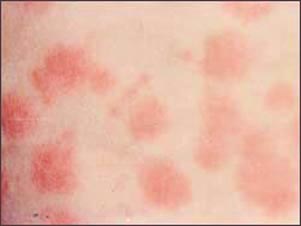
사진 71. 약물 알레르기로 생긴 피부 발진.
Copyright ⓒ 2013 John Sangwon Lee, MD.. FAAP
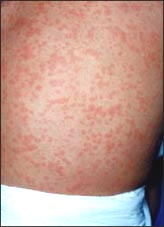
사진 72. 약물 알레르기로 생긴 피부 발진.
Copyright ⓒ 2013 John Sangwon Lee, MD.. FAAP
- 약물 치료를 받을 때 바라는 약물 치료효과 외에 생기는 약물치료관련 문제나 원하지 않는 약리작용이 나타나는 것을 약물 부작용이라 한다.
- 예를 들면 헤파린제(Heparin)로 혈액응고 문제가 있는 어떤 병을 치료할 때 출혈이 생길 수 있다.
- 이때 출혈은 헤파린으로 치료할 때 생기는 헤파린 약물 부작용이다.
- 약물 치료를 받을 때 약물 알레르기로 인해 아나필락시스 반응, 혈청병, 그 외 여러 가지 약물 알레르기, 약물 부작용, 약물 중독이 생길 수 있다.
- 약물 치료를 받을 때 항원 항체 이상반응으로 약물 알레르기도 생길 수 있고,
- 약물 알레르기가 아닌 약물 부작용, 또는 약물 유해 작용이 생길 수 있다.
- 약물 중독은 약물을 과량으로 사용해서도 생길 수 있고 그 외 조건에 의해서도 생길 수 있다.
- 어떤 병을 치료하기 위해 그 병에 적절한 약물을 선택해서 적절한 치료 용량으로 치료하는데도 약물로 인해서 부작용이 생길 수 있고, 그 약물로 인해서 약물 유해 작용이 생길 수 있다.
- 비정상적으로 쇠약한 신장, 간, 또는 다른 사람의 기관(器管)을 이식 받은 아이들,
- 어떤 질병으로 인하여 몸이 쇠약한 아이들,
- 아주 유약한 신생아들,
- 노쇠 노인들에게 생긴 어떤 질환을 아주 적절한 약물로 적절한 용량으로 치료할 때 그들에게 사용된 약물 대사가 건장한 사람들의 약물 대사와 같이 순조롭게 정상적으로 대사 되지 않을 수 있다.
- 건강하지 않은 환아들의 질병을 적절한 약물을 선택해 적절한 용량으로 치료할 때도 혈중 약 농도가 예기치 않게 비정상적으로 더 높아 그로 인해 약물 중독이나 약물 부작용이 생길 수 있다.
- 적절한 치료 용량으로 적절히 치료해도 어떤 약물은 특정 기관(器管)에 비정상적으로 과량으로 축적되어 그 기관의 기능이 저하되거나 상실될 수 있고 약물 부작용이나 약물 중독이 생길 수 있다.
- 어떤 감염병을 광범위 항생제로 장기간 치료할 때 호흡 기계·소화기계·피부계 등 인체계통의 상존 세균 무리나 곰팡이 무리가 비정상적으로 감소되거나 다 죽어 없어질 수 있다.
- 그 대신 평상시 상존하지 안했던 박테리아 무리 및, 또는 곰팡이 무리가 그 부위에 비정상적으로 더 많이 자라서 박테리아 무리 및, 또는 곰팡이 무리의 균형이 깨질 수 있다.
- 이 때 극히 해로운 박테리아 무리나 곰팡이 무리 등이 비정상적으로 많이 증식돼서 보통 때는 문제되지 않았던 비 상존 병원체 감염으로 생명에 위험한 중복감염이 생길 수 있다.- p.00 항생제 참조
- 결핵 치료약 아이나, 또는 그 외 약물로 약물 부작용이 간에 생겨 간염이 생길 수 있다.
- 클로람페니콜(Chloramphenicol)이나 그 외 약물로 부작용이 생겨 재생 불량 빈혈이 생길 수 있다. [부모도 반의사가 되어야한다-소아가정간호 백과]-제 13권 소아청소년 혈액, 림프, 종양 질환-재생 불량 빈혈 참조
- 카나마이신(Kanamycin)·스트렙토마이신(Streptomycin)·젠타마이신(Gentamicin) 등의 항생제 부작용으로 청신경이 손상될 수 있고, 귀가 먹을 수 있고 신장도 손상될 수 있다. 신장이 심하게 손상될 때 신장 부전증이 생겨 소변이 정상적으로 분비되지 않을 수 있다. [부모도 반의사가 되어야한다-소아가정간호 백과]-제 18권 소아청소년 이비인후 질환-약물과 난청 참조
- 백혈병이나 암 등을 치료하는 데 쓰는 항암제, 코르티코스테로이드제 등의 약물로 부작용이 생겨 면역 기능체계의 일부나 전체가 약화될 수 있고, 또 면역 기능 체계의 전부가 상실될 수 있다. 항암제 치료로 생긴 면역 기능 체계 이상으로 박테리아 감염이나 바이러스 감염, 또는 곰팡이 감염으로 감염병이 생길 수 있다. [부모도 반의사가 되어야한다-소아가정간호 백과]-제 13권 소아청소년 혈액, 림프, 종양 질환-약물로 인한 백혈구 감소증 참조
- 아스피린이나 그 밖의 약물로 부작용이 생겨 위장 점막층이 손상될 수 있고 위염이나 위궤양이 생길 수 있다. 아스피린 치료로 혈액 응고 지연과 출혈이 생길 수 있다.
- 아스피린 참조
약물 알레르기와 약물 유해 작용 Drug allergy and Drug adverse reaction
- 약물 유해 작용은 약물로 치료 받을 때 우리 몸에 유해하거나 거부 작용을 약물 유해 작용이라고 한다.
- 세계보건 기구는 약물 유해 작용을 영어 알파벳 ABCDEF 순서에 따라 외우기 쉽게 세분한다.
1. A 형 약물 유해 작용
- 강화 약리 작용-약의 용량과 예상했던 약물 유해 작용(Type A: Augmented pharmacologic effects – dose dependent and predictable).
- 항원 항체 면역 기전으로 생기지 않고 약물 특이체질 반응으로 생기지 않고 약물로 인한 해로운 불내성 반응 (Drug Intolerance)이 여기에 속할 수 있다.
2. B형 약물 유해 작용
- 약의 용량에 관련 없이 예상할 수 없었던 특이 약물 유해 작용(Type B: 특이 약물 반응(Bizarre effects or idiosyncratic)
- 약물 용량에 영향을 받지 않고 예측할 수 있으며(Dose independent and unpredictable) 항원 항체 면역 기전으로 생기지 않고 특이 체질로 인해 생기는 약물로 인한 해로운 반응을 약물 특이체질 반응(Drug Idiosyncratic reaction)이 여기에 속한다.
3. C 형 약물 유해 작용 Type C: Chronic effects
만성 약물 유해 작용
4. D 형 약물 유해 작용
Type D: Delayed effects 자연 약물 유해 작용
5. E 형: 약물 유해 작용
Type E: End-of-treatment effects
치료 종료 후 생기는 약물 유해 작용
6. F 형: 약물 유해 작용
Type F: Failure of therapy
치료효과가 없는 약물 유해 작용
약물 알레르기와 그 외 약물 문제 Drug allergy and other drug problems
- 이상 3가지 약물 반응 중 어떤 종류에 의해서 해로운 반응이 생겼는지 확실히 모르는 경우, 그 중 두 가지나 세 가지 약물 유해 작용이 동시에 함께 생길 수도 있다
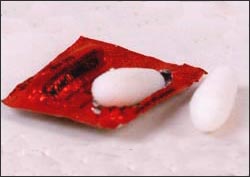
사진 44. 좌약으로 약물 알레르기,약물 부작용, 약물 유해 작용 등이 생길 수 있다.
Copyright ⓒ 2013 John Sangwon Lee, M.D., FAAP
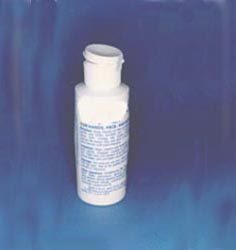
사진 40. 로션제로도 약물 알레르기, 약물 부작용, 약물 유해 작용 등이 생길 수 있다.
Copyright ⓒ 2013 John Sangwon Lee, M.D., FAAP
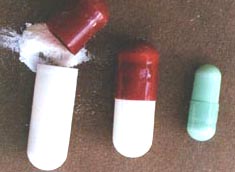
사진 38. 캡슐약으로 약물 알레르기, 약물 부작용, 약물 유해 작용 등이 생길 수 있다.
Copyright ⓒ 2013 John Sangwon Lee, M.D., FAAP
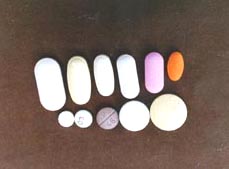
사진 39. 알약으로 약물 알레르기, 약물 부작용, 약물 유해 작용 등이 생길 수 있다.
Copyright ⓒ 2013 John Sangwon Lee, M.D., FAAP
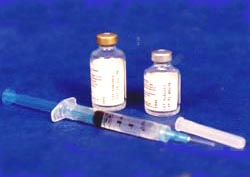
사진 45. 주사약으로 약물 알레르기, 약물 부작용, 약물 유해 작용 등이 생길 수 있다.
Copyright ⓒ 2013 John Sangwon Lee, M.D., FAAP
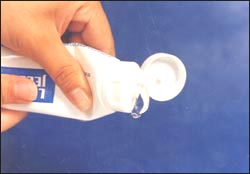
사진 46. 크림제로도 약물 알레르기, 약물 부작용, 약물 유해 작용 등이 생길 수 있다.
Copyright ⓒ 2013 John Sangwon Lee, M.D., FAAP

사진 53. 약물 부작용으로 생긴 약진(피부발진)
Copyright ⓒ 2013 John Sangwon Lee, MD,. FAAP
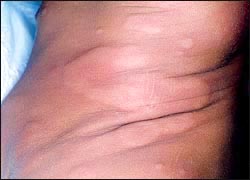
사진 48.두드러기(약물 부작용으로 생긴 약진).
Copyright ⓒ 2013 John Sangwon Lee, M.D., FAAP
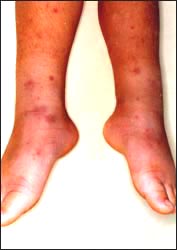
사진 50. 약물 부작용으로 생긴 자반(헤노흐-쇤라인 자색반).
Copyright ⓒ 2013 John Sangwon Lee, MD., FAAP
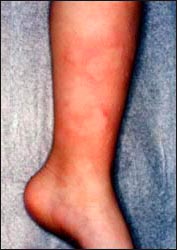
사진 51. 약물 부작용으로 생긴 두드러기.
Copyright ⓒ 2013 John Sangwon Lee, M.D., FAAP
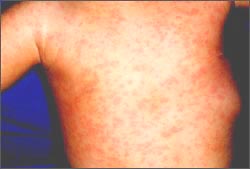
사진 52. 약물 부작용으로 생긴 약진(피부발진).
Copyright ⓒ 2013 John Sangwon Lee, MD., FAAP
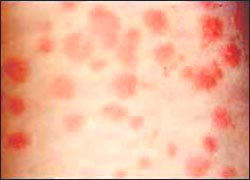
사진 49. 약물 부작용으로 생긴 약진(피부 발진).
Copyright ⓒ 2013 John Sangwon Lee., M.D., FAAP
약물 알레르기(약물 알러지) Drug allergy
- 약물 치료를 할 때 항원 항체 면역 이상반응은 약물 알레르기라고 한다.
- 어떤 약물이든 약물로 인해 약물 알레르기가 생길 가능성이 있다. 약물 알레르기를 약품 알레르기, 약물 알러지, 약물성 알러지, 또는 약물 유발 알러지라고도 한다.
- 1형 IgE 중개 기전으로 생긴 약물 알레르기가 있다. 그 예는 페니실린 아나필락시스 반응 이다.
- 비 1형 IgE 중개 기전으로 약물 알레르기가 생길 수 있다. 그 예는 약물로 인한 용혈성 빈혈 등 이다.
- 1형 IgE 중개 기전으로 생긴 약물 알레르기인지 비 1형 IgE 중개 기전으로 생긴 약물 알레르기인지 모르는 약물 알레르기도 있다.
- 약물 알레르기와 약물 부작용 두 가지가 동시 생겼는지 확실히 감별할 수 없는 때도 있다.
- 약물 알레르기인지, 약물 부작용인지 확실히 모를 때도 있다.
- 약물 아나필락시스 반응(아나필락시스)은 1형 IgE 중개 기전으로 생기는 일종의 약물 즉시 알레르기 반응이다. 아나필락시스 반응이 생기면 두드러기, 소양감, 후두 경련과 후두부종, 기관지 경련, 심장 혈관 부전증, 때로는 사망할 수 있다.
- 면역 복합체로 인한 약물 알레르기로 그 예는 혈청반응이다.
- 지연 약물 알레르기로 그 예는 접촉성 피부염이다.
Drug allergy
Overview of Drug Allergy
• When you are being treated with drugs
• o Drug allergy;
o Drug side effects;
o Drug adverse reaction;
o Other “drug problems” may arise.
• In other words, when receiving drug treatment, the four harmful reactions described above can occur in the body due to drugs www.drleepediatrics.com – Vol. 21 Home Nursing for Children and Adolescents – Refer to Drugs).
• Antigen-antibody immune adverse reactions when receiving drug treatment are called drug allergies.
• When being treated with any kind of drug, it is possible that the drug will cause a drug allergy.
• Drug allergy is also called drug allergy, drug allergy, drug allergy, or drug-induced allergy.
When treated with medications, the following adverse effects may occur:
• A type 1 IgE mediated mechanism may lead to drug allergy. An example is the penicillin anaphylactic reaction.
• Non-type 1 IgE mediated mechanisms may lead to drug allergy. Examples include drug-induced hemolytic anemia.
• In some drug allergies, it is not known whether a drug allergy is due to a type 1 IgE mediated mechanism or a drug allergy is caused by a non-type 1 IgE mediated mechanism.
• Sometimes it is not always possible to tell if both a drug allergy and a drug side effect occur at the same time.
• Sometimes you are not sure if it is a drug allergy or a drug side effect.
• Drug anaphylactic reaction is a type of immediate drug allergy caused by a type 1 IgE mediated mechanism.
• An anaphylactic reaction can cause hives, pruritus, laryngeal spasms and laryngeal edema, bronchospasm, cardiovascular insufficiency, and sometimes death.
• Drug allergies due to immune complexes may also occur. An example is a serological reaction.
• Delayed drug allergy may also develop. An example is contact dermatitis.
Drug allergy and drug side effects

Picture 71. Skin rash caused by drug allergy. Copyright ⓒ 2013 John Sangwon Lee, MD., FAAP

Picture 72. Skin rash caused by drug allergy. Copyright ⓒ 2013 John Sangwon Lee, MD., FAAP
• When receiving drug treatment, a drug treatment-related problem or unwanted pharmacological action that occurs other than the desired drug treatment effect is called a drug side effect.
• Bleeding can occur when treating certain conditions with blood clotting problems, for example with heparin.
• Bleeding is a side effect of heparin drugs that occurs when treated with heparin.
• When taking medication, drug allergy can cause anaphylactic reactions, serum sickness, other drug allergies, drug side effects, and drug addiction.
• When receiving drug treatment, drug allergy may also occur due to an antigen-antibody adverse reaction,
• You may experience drug side effects or adverse drug reactions that are not drug allergies.
• Drug addiction can be caused by excessive use of drugs or other conditions.
• In order to treat a certain disease, even when the appropriate drug is selected for the disease and treated at an appropriate therapeutic dose, side effects may occur due to the drug, and adverse effects may occur from the drug.
• Children who have had abnormally debilitated kidneys, livers, or other human organs;
• Children who are debilitated by some disease;
• Very fragile newborns;
• When certain diseases in frail elderly are treated with very appropriate drugs at appropriate doses, the drug metabolism used in them may not be as smooth and normal as that of healthy people.
• Even when the disease of unhealthy children is treated with the appropriate drug and the appropriate dose, the blood drug concentration is unexpectedly and abnormally higher, which can lead to drug addiction or drug side effects.
• Even with proper treatment at an appropriate therapeutic dose, certain drugs can accumulate in an abnormally excessive amount in a specific organ, leading to decreased or loss of function of that organ, and drug side effects or drug addiction.
• When a certain infectious disease is treated with broad-spectrum antibiotics for a long period of time, the existing bacterial or fungal clusters in the human system such as the respiratory, digestive, and skin systems may be abnormally reduced or killed.
• Instead, an unusually large number of bacteria and/or mold groups that were not normally present in the area can cause the bacteria and/or mold groups to become out of balance.
• At this time, a group of extremely harmful bacteria or fungus proliferates in an abnormally large number, which can lead to a life-threatening superinfection due to infection with a non-resident pathogen that is not normally a problem.- See p.00 Antibiotics
• Tuberculosis medication In children, or other medications, side effects may occur in the liver, resulting in hepatitis.
• Chloramphenicol or other medications may have side effects, resulting in aplastic anemia. www.drleepediatrics.com – See Volume 13 Children and Adolescent Blood, Lymphatic and Tumor Diseases – Aplastic Anemia
• The side effects of antibiotics such as Kanamycin, Streptomycin, and Gentamicin can damage the auditory nerve, deafness, and kidney damage. When the kidneys are severely damaged, kidney failure can occur and urine cannot be secreted normally. www. drleepediatrics.com-Volume 18 Children’s and Adolescent Otorhinolaryngology-Drugs and Hearing Loss Reference
• Drugs such as anticancer drugs and corticosteroids used to treat leukemia or cancer may have side effects, which may weaken some or all of the immune system, and may result in the loss of all of the immune system. Infectious diseases can occur due to bacterial infection, viral infection, or fungal infection due to an abnormality of the immune system caused by chemotherapy.www.drleepediatrics.com – Volume 13 Children and Adolescents Blood, Lymphatic, and Tumor Diseases – See Drug-induced Leukopenia
• Aspirin or other medications have side effects, which can damage the gastrointestinal mucosa and cause gastritis or gastric ulcers. Aspirin treatment may delay blood clotting and cause bleeding.
• See Aspirin
Drug allergy and drug adverse reaction
• Adverse drug effects are harmful to our body when treated with drugs or adverse effects are called adverse effects.
• The World Health Organization classifies adverse drug effects into easy-to-memorize alphabetical order of ABCDEF.
1. Type A drug adverse effects
• Augmented pharmacologic effects – dose dependent and predictable (Type A: Augmented pharmacologic effects – dose dependent and predictable).
• Antigen, which does not arise from an antibody immune mechanism, does not arise from a drug specific body reaction, and is not caused by a drug-induced harmful drug intolerance (Drug Intolerance) may belong to this category.
2. Type B drug adverse effects
• Unpredictable specific drug adverse events (Type B: Bizarre effects or idiosyncratic) regardless of the drug dose
• A drug idiosyncratic reaction that is dose independent and unpredictable, and is not caused by an antigen-antibody immune mechanism but due to a specific constitution, is a drug idiosyncratic reaction.
3. Type C: Chronic effects Chronic drug adverse effects
4. Type D drug adverse effects
Type D: Delayed effects Natural drug adverse effects
5. Type E: Drug Adverse Effects
Type E: End-of-treatment effects Adverse drug effects after the end of treatment
6. Type F: Drug Adverse Effects
Type F: Failure of therapy adverse drug reactions with no therapeutic effect
Drug allergy and other drug problems
• If it is not clear which of the above three drug reactions caused the adverse reaction, two or three of them may occur simultaneously.

Picture 44. Suppositories can cause drug allergy, drug side effects, and adverse drug reactions. Copyright ⓒ 2013 John Sangwon Lee, M.D., FAAP

Photo 40. Drug allergy, drug side effects, and adverse drug reactions can occur even with lotions. Copyright ⓒ 2013 John Sangwon Lee, M.D., FAAP

Picture 38. Drug allergy, drug side effects, and adverse drug reactions may occur with capsules. Copyright ⓒ 2013 John Sangwon Lee, M.D., FAAP

Photo 39. Drug allergy, drug side effects, and adverse drug reactions may occur with the pill. Copyright ⓒ 2013 John Sangwon Lee, M.D., FAAP

Picture 45. Injections can cause drug allergies, drug side effects, and adverse drug reactions. Copyright ⓒ 2013 John Sangwon Lee, M.D., FAAP

Picture 46. Even with a cream, drug allergy, drug side effects, and adverse drug reactions may occur. Copyright ⓒ 2013 John Sangwon Lee, M.D., FAAP

Picture 53. Leaking (skin rash) caused by drug side effects Copyright ⓒ 2013 John Sangwon Lee, MD., FAAP

Picture 48. Urticaria (a rash caused by a drug side effect). Copyright ⓒ 2013 John Sangwon Lee, M.D., FAAP

Picture 50. Purpura as a side effect of a drug (Henoch-Schoonlein purpura) Copyright ⓒ 2013 John Sangwon Lee, MD., FAAP

Picture 51. Hives caused by drug side effects. Copyright ⓒ 2013 John Sangwon Lee, M.D., FAAP Picture 52. A rash (skin rash) caused by a drug side effect. Copyright ⓒ 2013 John Sangwon Lee, MD., FAAP

Picture 49. Leaks (skin rash) caused by drug side effects. Copyright ⓒ 2013 John Sangwon Lee., M.D., FAAP
Drug allergy
• Antigen-antibody immune adverse reaction during drug treatment is called drug allergy.
• Any drug has the potential to cause a drug allergy. Drug allergy is also called drug allergy, drug allergy, drug allergy, or drug-induced allergy.
• There is a drug allergy resulting from a type 1 IgE mediated mechanism. An example is the penicillin anaphylactic reaction.
• Non-type 1 IgE mediated mechanisms may lead to drug allergy. Examples include drug-induced hemolytic anemia.
• In some drug allergies, it is not known whether a drug allergy is due to a type 1 IgE mediated mechanism or a drug allergy is caused by a non-type 1 IgE mediated mechanism.
• Sometimes it is not always possible to tell if both a drug allergy and a drug side effect occur at the same time.
• Sometimes you are not sure if it is a drug allergy or a drug side effect.
• Drug anaphylactic reaction (anaphylaxis) is a type of immediate drug allergic reaction caused by a type 1 IgE mediated mechanism. Anaphylactic reactions can cause hives, pruritus, laryngeal spasms and laryngeal edema, bronchospasm, cardiovascular insufficiency, and sometimes death.
• Drug allergy due to immune complexes, for example a serological reaction.
• Delayed drug allergy, for example, contact dermatitis.
출처 및 참조 문헌 Sources and references
- NelsonTextbook of Pediatrics 22ND Ed
- The Harriet Lane Handbook 22ND Ed
- Growth and development of the children
- Red Book 32nd Ed 2021-2024
- Neonatal Resuscitation, American Academy Pediatrics
- A SUPPLEMENT TO PEFDIATRICS, SYNAPSIS BOOK, BEST ARTICLES RELEVANT TO PEDIATRIC ALEERGY, ASTHMA, IMMUNULOGY, PEDIATRICS OFFICIAL JOURNAL OF THE AMERICAN ACADEMY.12/2019
- www.drleepediatrics.com 제1권 소아청소년 응급 의료
- www.drleepediatrics.com 제2권 소아청소년 예방
- www.drleepediatrics.com 제3권 소아청소년 성장 발육 육아
- www.drleepediatrics.com 제4권 모유,모유수유, 이유
- www.drleepediatrics.com 제5권 인공영양, 우유, 이유식, 비타민, 미네랄, 단백질, 탄수화물, 지방
- www.drleepediatrics.com 제6권 신생아 성장 발육 육아 질병
- www.drleepediatrics.com제7권 소아청소년 감염병
- www.drleepediatrics.com제8권 소아청소년 호흡기 질환
- www.drleepediatrics.com제9권 소아청소년 소화기 질환
- www.drleepediatrics.com제10권. 소아청소년 신장 비뇨 생식기 질환
- www.drleepediatrics.com제11권. 소아청소년 심장 혈관계 질환
- www.drleepediatrics.com제12권. 소아청소년 신경 정신 질환, 행동 수면 문제
- www.drleepediatrics.com제13권. 소아청소년 혈액, 림프, 종양 질환
- www.drleepediatrics.com제14권. 소아청소년 내분비, 유전, 염색체, 대사, 희귀병
- www.drleepediatrics.com제15권. 소아청소년 알레르기, 자가 면역질환
- www.drleepediatrics.com제16권. 소아청소년 정형외과 질환
- www.drleepediatrics.com제17권. 소아청소년 피부 질환
- www.drleepediatrics.com제18권. 소아청소년 이비인후(귀 코 인두 후두) 질환
- www.drleepediatrics.com제19권. 소아청소년 안과 (눈)질환
- www.drleepediatrics.com 제20권 소아청소년 이 (치아)질환
- www.drleepediatrics.com 제21권 소아청소년 가정 학교 간호
- www.drleepediatrics.com 제22권 아들 딸 이렇게 사랑해 키우세요
- www.drleepediatrics.com 제23권 사춘기 아이들의 성장 발육 질병
- www.drleepediatrics.com 제24권 소아청소년 성교육
- www.drleepediatrics.com 제25권 임신, 분만, 출산, 신생아 돌보기
- Red book 29th-31st edition 2021
- Nelson Text Book of Pediatrics 19th- 21st Edition
- The Johns Hopkins Hospital, The Harriet Lane Handbook, 22nd edition
- 응급환자관리 정담미디어
- Pediatric Nutritional Handbook American Academy of Pediatrics
- 소아가정간호백과–부모도 반의사가 되어야 한다, 이상원 저
- The pregnancy Bible. By Joan stone, MD. Keith Eddleman, MD
- Neonatology Jeffrey J. Pomerance, C. Joan Richardson
- Preparation for Birth. Beverly Savage and Dianna Smith
- 임신에서 신생아 돌보기까지. 이상원
- Breastfeeding. by Ruth Lawrence and Robert Lawrence
- Sources and references on Growth, Development, Cares, and Diseases of Newborn Infants
- Emergency Medical Service for Children, By Ross Lab. May 1989. p.10
- Emergency care, Harvey Grant and Robert Murray
- Emergency Care Transportation of Sick and Injured American Academy of Orthopaedic Surgeons
- Emergency Pediatrics A Guide to Ambulatory Care, Roger M. Barkin, Peter Rosen
- Quick Reference To Pediatric Emergencies, Delmer J. Pascoe, M.D., Moses Grossman, M.D. with 26 contributors
- Neonatal resuscitation Ameican academy of pediatrics
- Pediatric Nutritional Handbook American Academy of Pediatrics
- Pediatric Resuscitation Pediatric Clinics of North America, Stephen M. Schexnayder, M.D.
-
Pediatric Critical Care, Pediatric Clinics of North America, James P. Orlowski, M.D.
-
Preparation for Birth. Beverly Savage and Dianna Smith
-
Infectious disease of children, Saul Krugman, Samuel L Katz, Ann A.
- 제4권 모유, 모유수유, 이유 참조문헌 및 출처
- 제5권 인공영양, 우유, 이유, 비타민, 단백질, 지방 탄수 화물 참조문헌 및 출처
- 제6권 신생아 성장발육 양호 질병 참조문헌 및 출처
- 소아과학 대한교과서
Copyright ⓒ 2014 John Sangwon Lee, MD., FAAP
“부모도 반의사가 되어야 한다”-내용은 여러분들의 의사로부터 얻은 정보와 진료를 대신할 수 없습니다.
“The information contained in this publication should not be used as a substitute for the medical care and advice of your doctor. There may be variations in treatment that your doctor may recommend based on individual facts and circumstances.
“Parental education is the best medicine.